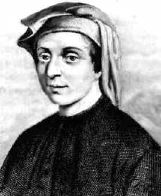

Leonardo Pisano is better known by his nickname Fibonacci.
He was born in Italy but was educated in North Africa where his father held a diplomatic post. Fibonacci was taught mathematics in Bugia and travelled widely with his father, recognising the enormous advantages of the mathematical systems used in the countries they visited.
Fibonacci ended his travels around the year 1200 and at that time he returned to Pisa. There he wrote a number of important texts which played an important role in reviving ancient mathematical skills and he made significant contributions of his own. Of his books we still have copies of Liber abbaci (1202), Practica geometriae (1220), Flos (1225), and Liber quadratorum(1225).
Even at a time when Europe was little interested in scholarship, there was widespread interest in Fibonacci's work. Fibonacci was a contemporary of Jordanus, but he was a far more sophisticated mathematician and his achievements were clearly recognised, although it was the practical applications rather than the abstract theorems that made him famous to his contemporaries.
Liber abbaci was based on the arithmetic and algebra that Fibonacci had accumulated during his travels. The book, which went on to be widely copied and imitated, introduced the Hindu-Arabic place-valued decimal system and the use of Arabic numerals into Europe. Indeed, although mainly a book about the use of Arab numerals, which became known as algorism, simultaneous linear equations are also studied in this work. The second section of Liber abbaci contains a large collection of problems aimed at merchants. They relate to the price of goods, how to calculate profit on transactions, how to convert between the various currencies in use in Mediterranean countries, and problems which had originated in China. In the third section were problems involving perfect numbers, problems involving the Chinese remainder theorem and problems involving summing arithmetic and geometric series.
A problem in the third section of Liber abbaci was:
"A certain man put a pair of rabbits in a place surrounded on all sides by a wall. How many pairs of rabbits can be produced from that pair in a year if it is supposed that every month each pair begets a new pair which from the second month on becomes productive?"
The resulting sequence is 1, 1, 2, 3, 5, 8, 13, 21, 34, 55, . . . , in which each number is the sum of the two preceding numbers, is now called the Fibonacci sequence. This sequence has proved extremely fruitful and appears in many different areas of mathematics and science.
Another of Fibonacci's books is Practica geometriae, which contains a large collection of geometry problems arranged into 8 chapters with theorems based on Euclid's Elements and On Divisions. In addition to geometrical theorems with precise proofs, the book includes practical information for surveyors, including a chapter on how to calculate the height of tall objects using similar triangles. The final chapter presents the calculation of the sides of the pentagon and the decagon from the diameter of circumscribed and inscribed circles.
The Holy Roman emperor, Frederick II, became aware of Fibonacci's work. A member of Frederick's court presented a number of problems as challenges to the great mathematician Fibonacci. In Flos, 3 of these problems were solved by Fibonacci. In one, he approximates the solution to 10x + 2x2 + x3 = 20 to 9 decimal places.
Liber quadratorum, written in 1225, is Fibonacci's most impressive piece of work, although not the work for which he is most famous. The book's name means the "Book of Squares" and it is a number theory book which, among other things, examines methods to find Pythogorean triples. Fibonacci first notes that square numbers can be constructed as sums of odd numbers, essentially describing an inductive construction using the formula n2 + (2n+1) = (n+1)2. Fibonacci also proves many interesting number theory results such as: there is no x, y such that x2 + y2 and x2 – y2 are both squares, and
x4 – y4 = z2 has no non-trivial integral solutions.
He also defined the concept of a congruum, a number of the form ab(a + b)(a – b), if a + b is even, and 4 times this if a + b is odd. Fibonacci proved that a congruum must be divisible by 24 and he also showed that for x, c such that x2 + c and x2 – c are both squares, then c is a congruum. He also proved that a square cannot be a congruum.
The Liber quadratorum alone ranks Fibonacci as the major contributor to number theory between Diophantus and the seventeenth century French mathematician Pierre de Fermat.
In 1240, the Republic of Pisa gave him a salary in recognition for the services that he had given to the city, advising on matters of accounting and teaching the citizens.